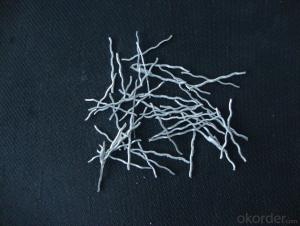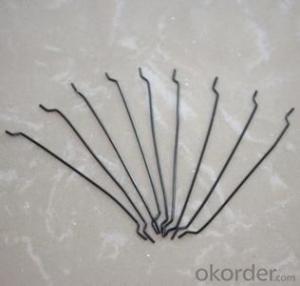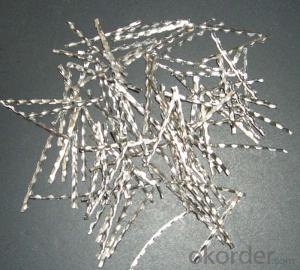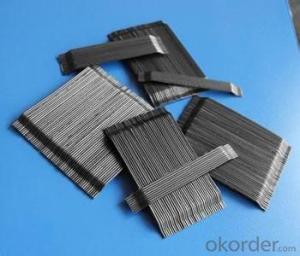Melt Extract Stainless Steel Fiber Reinforced Concrete Admixtures from CNBM China
- Loading Port:
- Tianjin
- Payment Terms:
- TT OR LC
- Min Order Qty:
- 1000 kg
- Supply Capability:
- 250000 kg/month
OKorder Service Pledge
OKorder Financial Service
You Might Also Like
Quick Details
Place of Origin: Shandong, China (Mainland)
Model Number: steel fiber
material: steel wire
application: concrete reinocement
type: end hook steel fiber
Product features
with excellent tensile ,hightenacity ,against cracking and fatigue ,they`re widely usd in the structures made of concrete
Service Temperature:
Melting Point | Recommended Maximum Service Temperature | ||||
310 | 1380-1455℃ | Cyclic Heating | 1000℃ | Continuous Service | 850℃ |
Dimensions:
Lengths are 6/10/15/25/30/50/60mm. Other lengths can be manufactured specifically to suit customer’s requirements.
Equivalent diameter 0.2/0.4/0.5/0.6/0.75/1.0mm. Other diameters can be manufactured specifically to suit customer’s requirements.
Packing:
Fibres are packed in 1/5/10/20kg cartons then put on pallets. Other packaging can be supplied if requested.
Using method and using quantity:
Usually use 0.2-2% ( volume ) of steel fiber in refractories or concrete materials, mixed evenly to maximize the use effect of steel fiber into full play. Mix method :1. Wet mix; 2. Dry mix.
In order to prevent explosions & radiation for concrete buildings , it is recommended to use steel fibres number 40-60% (volume).
Specifications
1.hooked steel fiber
2.CE and ISO9001:2008
3.diameter from 0.5mm to 1.2mm
4.competitive price,high quality and service
Hooked Steel Fiber:
1.Diameter:0.5mm-1.0mm
2.Length: 25mm-60mm
3.Material: low carbon steel wire
4.Feature: excellent tensile,high tenacity,against cracking,impact and fatigue
5.Uses: high way,tunnel,building,airport road serface and so on .
Picture
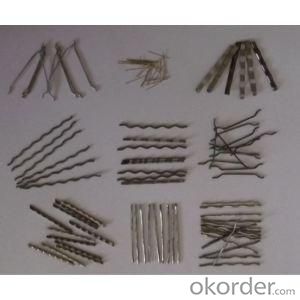
steel fiber concrete reinforced

any type steel fiber

FAQ
we can produce any type steel fiber and of course we can make production according to your requirement
we have specilize in this field for almost 10 years ,with good quality and competitive price
with excellent tensile ,hightenacity ,against cracking and fatigue ,they`re widely usd in the structures made of concrete
- Q: Can melt extract stainless steel fiber be used in refractory concrete applications?
- Certainly, melt extract stainless steel fiber can be utilized in refractory concrete applications. Refractory concrete, a specialized type of concrete specifically engineered to withstand extreme heat conditions while maintaining strength and structural integrity, can greatly benefit from the incorporation of stainless steel fibers. The manufacturing process of melt extract stainless steel fibers involves rapid cooling and solidification of molten stainless steel, resulting in the formation of thin and elongated fibers. These fibers possess exceptional thermal conductivity, high tensile strength, and effective corrosion resistance, rendering them highly suitable for use in refractory concrete. The addition of stainless steel fibers to refractory concrete offers significant advantages in terms of thermal shock resistance, crack resistance, and overall mechanical properties. By acting as reinforcement within the concrete matrix, the fibers effectively distribute stress and prevent the formation of cracks, thereby improving the concrete's ability to withstand thermal cracking and spalling caused by sudden temperature changes. As a result, the durability and longevity of refractory concrete in high-temperature environments are substantially enhanced. Moreover, stainless steel fibers also enhance the mechanical properties of refractory concrete. They increase the concrete's tensile strength and flexural strength, bolstering its resistance to mechanical stress and ensuring structural integrity even at elevated temperatures. In conclusion, melt extract stainless steel fiber is an excellent choice for use in refractory concrete applications. Its incorporation significantly enhances the thermal shock resistance, crack resistance, and mechanical properties of refractory concrete, thereby elevating its durability and reliability in high-temperature environments.
- Q: Is melt extract stainless steel fiber suitable for use in dam construction?
- Indeed, melt extract stainless steel fiber proves to be an appropriate choice for incorporation in dam construction projects. Renowned for its remarkable tensile strength, resistance to corrosion, and exceptional durability, stainless steel fiber stands as an ideal material to reinforce concrete in the construction of dams. By enhancing the mechanical properties of concrete, such as crack resistance and impact resistance, the fibers effectively contribute to the overall structural integrity of the dam. Moreover, the stainless steel fibers exhibit superb resistance to alkalis and chemicals that commonly exist within dam environments, guaranteeing their long-lasting performance without degradation or corrosion. This, in turn, further strengthens the suitability of stainless steel fibers for dam construction.
- Q: What is the effect of melt extract stainless steel fiber on the deflection of concrete slabs?
- The addition of melt extract stainless steel fiber to concrete slabs has a positive effect on their deflection. The high tensile strength and flexibility of the fibers help to enhance the overall structural integrity of the slabs, reducing deflection and improving their load-bearing capacity. The stainless steel fibers also contribute to crack control and durability, minimizing the risk of cracking and improving the overall performance of the concrete slabs.
- Q: Can melt extract stainless steel fiber be used in industrial flooring applications for shotcrete?
- Melt extract stainless steel fiber is a suitable option for shotcrete applications in industrial flooring. Shotcrete is a construction method that involves spraying concrete onto a surface using air pressure, resulting in a fast and efficient way to create a strong and durable floor. By incorporating stainless steel fiber into the shotcrete mix, the overall performance and durability of the flooring system can be enhanced. To produce melt extract stainless steel fiber, stainless steel is melted and then rapidly extracted into fine fibers. These fibers are known for their high tensile strength, resistance to corrosion, and toughness. When added to shotcrete, they contribute to improved crack resistance, impact resistance, and overall durability of the floor. In industrial environments where floors are subjected to heavy loads, impacts, and abrasion, using stainless steel fiber in shotcrete can offer significant advantages. It helps to minimize cracking, enhance resistance to wear and tear, and extend the lifespan of the floor. Moreover, stainless steel fiber can augment the fire resistance of shotcrete flooring, making it appropriate for industrial settings where fire safety is a concern. Overall, melt extract stainless steel fiber is an excellent choice for shotcrete applications in industrial flooring. It provides enhanced performance, durability, and fire resistance, making it a dependable solution for industrial settings that require robust and long-lasting flooring.
- Q: Can melt extract stainless steel fiber be used in high-temperature environments?
- Indeed, high-temperature environments can accommodate the usage of melt extract stainless steel fiber. Due to its remarkable heat resistance capabilities, stainless steel is a fitting material for situations involving elevated temperatures. Melt extract stainless steel fibers are usually crafted from a superior stainless steel alloy that offers improved protection against oxidation and corrosion at higher temperatures. Their structural integrity remains intact even when subjected to temperatures as high as 1200°C (2192°F). Consequently, these fibers find widespread application in industries like aerospace, automotive, and refractories, which commonly encounter high-temperature settings.
- Q: What is the effect of melt extract stainless steel fiber on the early-age cracking of concrete?
- Reducing early-age cracking in concrete can be achieved through the utilization of melt extract stainless steel fiber. There are various factors that contribute to early-age cracking, including temperature fluctuations, shrinkage, and rapid moisture loss. By incorporating stainless steel fibers into the concrete mixture, the overall tensile strength of the material is enhanced, providing reinforcement. This reinforcement plays a crucial role in controlling the formation and propagation of cracks during the initial stages of concrete curing. The exceptional properties of melt extract stainless steel fibers, such as their high tensile strength, resistance to corrosion, and durability, make them an ideal choice for mitigating early-age cracking. These fibers effectively disperse stress throughout the concrete matrix, restricting the initiation and spread of cracks. Furthermore, melt extract stainless steel fibers can also aid in managing plastic shrinkage cracking. During the early stages of concrete curing, rapid loss of moisture can cause the surface to shrink and crack. By incorporating stainless steel fibers, this shrinkage is restrained, thereby reducing the likelihood of early-age cracking. It is worth noting that the precise impact of melt extract stainless steel fiber on early-age cracking may vary depending on factors such as the dosage of fibers, the design of the concrete mix, and environmental conditions. Therefore, comprehensive testing and consultation with experts are essential to determine the optimal dosage and application of fibers for a specific project.
- Q: Can melt extract stainless steel fiber be used in the construction of power plant structures?
- Yes, melt extract stainless steel fiber can be used in the construction of power plant structures. These fibers are known for their high temperature resistance, corrosion resistance, and durability, making them suitable for applications in power plants where extreme conditions such as high temperatures, pressure, and chemicals are present. They can enhance the strength and performance of concrete and other construction materials used in power plant structures, providing added reinforcement and ensuring long-term structural integrity.
- Q: How is melt extract stainless steel fiber produced?
- Specialized manufacturing processes are used to produce melt extract stainless steel fiber. Initially, high-quality stainless steel alloy is melted in a furnace at extremely high temperatures. The molten steel is then forced through a spinneret, which is a fine nozzle with multiple small holes. As the molten steel passes through these holes, it solidifies and forms thin fibers. After the fibers are formed, they are rapidly cooled and solidified by passing them through a cooling chamber or a quench bath. This ensures that the fibers maintain their desired shape and strength. Once cooled, the fibers are gathered and further processed to eliminate any impurities or contaminants. Typically, the collected stainless steel fibers are cut into shorter lengths to enhance their usability in various applications. They can also undergo additional processing to modify their surface properties, such as applying a protective layer or different surface treatments. The melt extract process allows for the production of stainless steel fibers that have consistent dimensions and properties. These fibers possess excellent tensile strength, corrosion resistance, and high thermal conductivity, making them suitable for a broad range of applications. They are commonly utilized in industries such as concrete reinforcement, refractories, filtration systems, and as conductive additives.
- Q: The heavy steel fiber feifanshi supeiflat floor for what?
- Feifanshi steel fiber heavy-duty supeiflat floor walk forklift high level rack of logistics distribution center
- Q: Can melt extract stainless steel fiber be used in tunnel segments?
- Melt extract stainless steel fiber is indeed applicable for tunnel segments. It is a common practice to incorporate stainless steel fibers into concrete mixtures for the purpose of enhancing the material's mechanical properties and increasing its durability. By incorporating stainless steel fibers, the strength and crack resistance of concrete segments in tunnel construction can be significantly improved, thereby minimizing the likelihood of structural failures. Furthermore, stainless steel fibers offer superior resistance to corrosion, making them a suitable choice for tunnel segments that may face moisture or aggressive environments. Consequently, melt extract stainless steel fiber can be utilized effectively in tunnel segments to enhance their structural integrity and prolong their lifespan.
Send your message to us
Melt Extract Stainless Steel Fiber Reinforced Concrete Admixtures from CNBM China
- Loading Port:
- Tianjin
- Payment Terms:
- TT OR LC
- Min Order Qty:
- 1000 kg
- Supply Capability:
- 250000 kg/month
OKorder Service Pledge
OKorder Financial Service
Similar products
Hot products
Hot Searches
Related keywords
